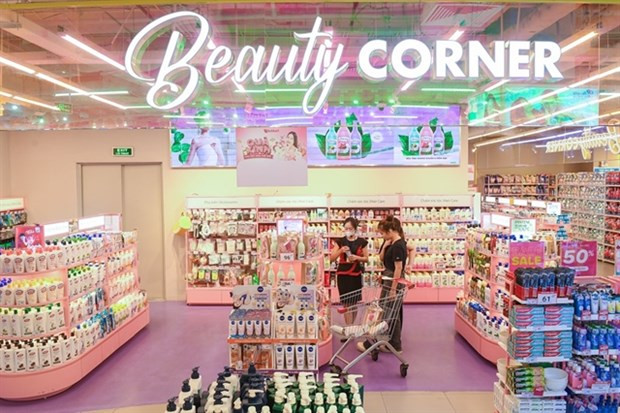
A beauty corner at WinMart Thang Long, Hanoi. (Photo; VNA)
According to data and business intelligence platform Statista, foreign beauty brands are popular.
Brands from the Republic of Korea have established themselves as the leading players in Vietnam’s cosmetics market. Statistics showed the Republic of Korea was Vietnam’s largest export partner for cosmetics with export value reaching around 330 million USD in 2022.
Apart from RoK brands, Vietnamese consumers also enjoy using Japanese and European brands.
Despite the fierce competition and the high consumer preference for international brands, local businesses have been gradually asserting their position. Brands such as Cocoon, M.O.I Cosmetics, Lemonade, and more have also been, step by step, gaining popularity among consumers by offering affordable yet high-quality products.
Still, local brands hold a modest share, estimated at around 10%, of a 2.3 billion USD market.
Vietnam’s cosmetics market is thriving, thanks to young consumers entering the market and a rising middle class.
Statista pointed out that Vietnam is among the countries with the highest average salary growth rate in the Asia – Pacific region. “As people have more disposable income, the demand for various consumer goods has been increasing in the country, especially for cosmetics and personal care items”.
With the post-COVID-19 economic recovery underway, international trade has regained momentum. Together with the rise of e-commerce, spending on cosmetic products is increasing, with a surge in revenue for the beauty and personal care market in Vietnam expected in the coming years, Statista wrote.
The revenue in the beauty and personal care market in Vietnam is projected to reach 2.66 billion USD by 2024 with an annual growth rate of 2.97% in 2024-28.
The per-person revenue in Vietnam is projected to be at 26.77 USD in 2024.
A report by Nielsen showed Vietnam’s average per-person spending in cosmetics is still modest but increasing year-on-year, estimated at around VNĐ500,000-700,000 per month.
According to Statista, thanks to Vietnam’s digital-savvy population, the use of e-commerce has been expanding rapidly in recent years.
Cosmetics has consistently been among the leading online shopping categories in the country, especially among urban consumers.
“With more and more people comfortable shopping for these items online, brands have been tailoring their customer journey to meet the new demand for online services.”
For instance, virtual try-on services have recently become popular among beauty brands in Việt Nam, providing consumers with an interactive product demonstration using augmented reality technologies.
“New digital innovations employed within the cosmetics market are expected to continuously improve the consumer journey with online shopping, helping e-commerce to overtake physical retail stores as the go-to destination for beauty and personal care products in the near future.”
In addition, social media has played a crucial role in shaping beauty trends in Vietnam.
Statista estimated that online sales would contribute 20.2% of total revenue in the beauty and personal care market by 2024.
A report by e-commerce data platform Metric showed that revenue of beauty and personal care products on e-commerce platforms reached 22.2 trillion VND in the first 10 months of 2023, rising by 74% over 2022.
Tin Le, founder cum CEO of Adtek, said that as cosmetics brands are all promoting sales via e-commerce platform, local brands should focus on ensuring product quality to attract and keep customers.
In addition, focus should also be on catching beauty trends as Vietnamese consumers are increasingly embracing natural and organic beauty products, together with designing, branding and marketing strategies./.VNS